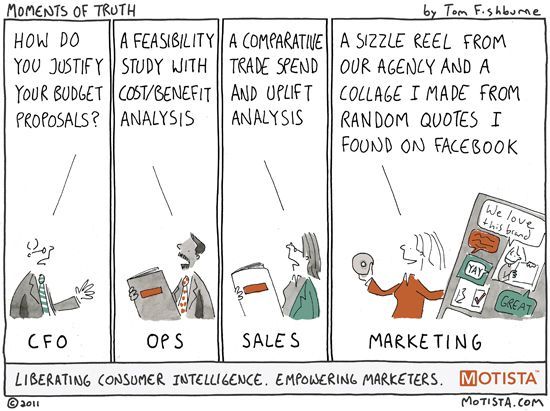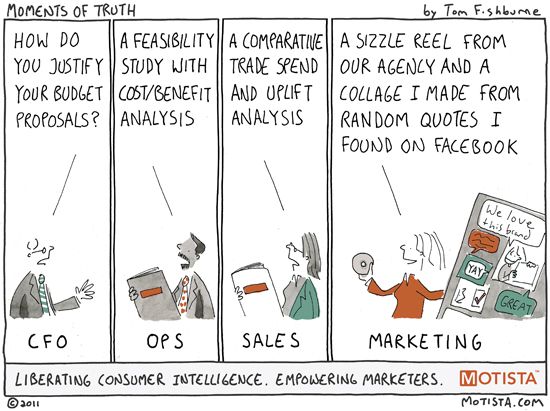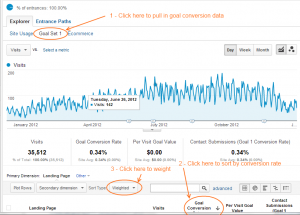
Last year I saw a quote that managed to lodge itself in my brain for the past 6 months. It was from a crowd-sourced SEOMoz post on career advice for SEOs:
Build a reputation for using data. Why? Well, the numbers usually speak for themselves and their message is usually more powerful than yours.
–Jonathon Colman
Toss that around for a minute while I share another quote. This one is from Bill Sebald’s recent post, Case Study (Or It Didn’t Happen):
I want to see more proof.
There’s a time and place for theoretical marketing posts (including SEO); I’ve written my share. I dislike when these same posts suggest facts that haven’t been proven, or when they raise more questions than they answer. As content producers we need to be conscious of this.
-Bill Sebald
Both of these quotes are circling around the same concept:
Data Builds Credibility

When used appropriately, data removes subjectivity from the conversation.
Good data is reliable, empirical, and objective.
Good data can back up the wildest claims.
- Using data is like having an unwavering testimonial for the case you’re trying to make.
It doesn’t matter if you’re convincing a client that you’ve helped build sales, convincing your boss that you deserve a raise, or making a business case for a new marketing initiative – data helps you build a more credible case.
This post applies to both professionals and organizations.
Building a reputation for using data is something we need to do as professionals, and something we need to do as organizations.
Both have reputations that need to be built up carefully and purposefully, and the reputation of an organization is tied to the reputation of its people, and vice versa.
Data Depersonalizes Decision-Making

I borrowed this headline from Avinash Kaushik’s presentation on Seven Steps to Creating a Data Driven Decision Making Culture.
Gut decisions might feel good, but data-driven decision making takes personal conflict and feelings out of the situation, and focuses the discussion on the facts we have in front of us.
Avinash’s post talks about HiPPOs: Highest Paid Person’s Opinion:
HiPPO’s rule the world, they over rule your data, they impose their opinions on you and your company customers, they think they know best (sometimes they do), their mere presence in a meeting prevents ideas from coming up.
The solution to this problem is to depersonalize decision making, simply don’t make it about you or what you think. Go outside, get context from other places. Include external or internal benchmarks in your analysis. Get competitive data (we are at X% of ZZ metric and our competition is at X+9% of ZZ metric).
-Avinash Kaushik
This works down the corporate ladder, too:
Data gives us an objective way to deliver critical feedback without calling a person’s self-worth into question. As a manager, which of the following statements builds more respect from an under-performing employee?
- Your performance has been lagging compared to the rest of the customer service team.
- Your average response time is 35% higher than the rest of the customer service team.
Option #2 focuses an otherwise ugly conversation on a measurable performance indicator, and at the same time gives you a framework to fix the problem, rather than relying on a “gut metric.”
People Buy Things for Results

This one isn’t rocket science – people buy things to fill needs. Basic needs, emotional needs, psychological needs, etc.
The results you produce help people quantify how well you fill their needs.
- When clients hire your company, they’re looking for results.
- When companies hire you, they’re looking for results.
- When customers buy your product, they’re looking for results.
How do we measure results? Data is one of the best ways:
- “On average our clients saw a 12% reduction in manufacturing costs, which resulted in a 240% average return on investment in the first year they hired us.”
- “At my last job, I oversaw PR for a product launch that contributed to 25% of the company’s annual growth. We were able to tie 30% of product sales directly to press received.”
- “Our trucks tow 20% more weight than the competition, and gets 12% better gas mileage.”
People decide which options will fill their needs best by using the information they have available. The results and the data you put forth helps them decide to choose you.
When Can You Use Data to Build Credibility?
Strive to use data to justify your position every time you make a claim while interacting with clients, managers, and peers:
- Publishing case studies and white papers that are focused on numbers and facts, rather than conjecture.
- Requiring the use of data as support for all business decisions in an organization.
- Tying resume entries to results you’ve achieved.
- Focusing on improving measurable results during ongoing client reporting.
- Referencing data when having debates on social media and blog comments.
- Giving customers better product information on product sales pages.
Use Data To Tell Stories
There’s a second part of the quote at the beginning of this article that I left out:
Be a good storyteller. Except that data doesn’t speak for itself. Neither does a business case, I’ve found. Even ROI figures are open to interpretation. So the most successful SEOs add elements of human connection, drama, and creativity to the way they tell their stories. Humans evolved to share and consume stories — it’s part of the way we learn new information — and good SEOs are aware of that trait and use it to grow their success.”
-Jonathon Colman
At first I thought it was a bit funny that Jonathon started out by saying that “numbers usually speak for themselves” and moments later followed up with “except that data doesn’t speak for itself.”
After thinking about it for a bit it occurred to me that at the end of the day, as marketers, we’re using data to persuade. Persuasion requires subjectivity – persuasion requires an opinion. But by grounding our opinions in data, we can build objectivity into our arguments, and we can use data to break down objections to our case.
You can approach this two ways – observe data and make a compelling case out of it, or make a compelling case and find data to support it.
4 Ways to Make This Post Actionable
1) Take a look back at the past year and find places for improvement.
Take a look at the claims you’ve made in the past year, either publicly or in your organization, and find one that you didn’t back up with data. Go find data that supports it or refutes it, and if you can’t, figure out a way you can test it yourself.
I personally have a couple examples of claims I’ve made in the past year that I could have supported better that I’ll be sharing here in the future.
2) Look for interesting internal data to publish.
Figure out what data your organization has that you can publish. Internal data is an immense source of content and one that no one else can publish. That makes it a great way to differentiate yourself from competitors.
Take a look at this example from CX Partners on internal Above/Below the Fold user testing data from 2009. It has 163 comments, and 47 linking root domains in Open Site Explorer.
3) Look for existing content on your website that could be improving by adding new data.
Case studies are a great place to start, because they’ll probably improve the conversion rate for website visitors already looking to hire you.

Look through Google Analytics for other pages on your site that were frequently viewed by users prior to converting. One method is to check landing pages that end with the highest conversion rate. Those are great places to add data, even in the form of single sentences:
- “79% of our customers say our software is now part of their daily workflow.”
E-commerce providers – start surveying your buyers with statements such as “would you buy this product again?” After gathering this data for long enough, you can publish it on the product page in a manner like this:
- “68% of the last 156 people who bought this product said they would buy it again.”
Doing this pulls in social proof as well, and I bet doing it site wide would help conversions overall. (Did you catch that claim without data? Someone with an e-commerce store please test this and report back.)
4) Prioritize building data into your content marketing efforts more often.
This one speaks for itself. Make the use of data a habit, and you’ll build a reputation for using data.
Now I’m putting the question back to you – where else can we use data to improve our credibility?
✉️ Get an email when we publish new content:
Don't worry, we won't bug you with junk. Just great content marketing resources.
Ready To Try
Content Harmony?
Get your first 10 briefs for just $10
No trial limits or auto renewals. Just upgrade when you're ready.

You Might Also Like:
- The Wile E. Coyote Approach To Content Guidelines
- Content Brief Templates: 20 Free Downloads & Examples
- The Keyword Difficulty Myth
- How To Find Bottom of Funnel (BoFU) Keywords That Convert
- Bottom of Funnel Content: What Is BOFU Content & 10 Great Examples
- 20 Content Refresh Case Studies & Examples: How Updating Content Can Lead to a Tidal Wave of Traffic 🌊
- How to Create Editorial Guidelines [With 9+ Examples]
- Content Marketing Roles
- How To Write SEO-Focused Content Briefs
- The Content Optimization Framework: [Intent > Topic > UX]
- How To Update & Refresh Old Website Content (And Why)
- 12 Content Marketing KPIs Worth Tracking (And 3 That Aren't)
- 16 Best Content Writing Tools in 2024 (Free & Paid)
- How to Create a Content Marketing Strategy [+ Free Template]
- How To Create Content Marketing Proposals That Land The Best Clients
- What Is A Content Brief (And Why Is It Important)?
- How To Create A Dynamite Editorial Calendar [+ Free Spreadsheet Template]
- How to Use Content Marketing to Improve Customer Retention
- Types of Content Hubs: 5 Approaches & 30+ Examples
- How To Do A Content Marketing Quick Wins Analysis